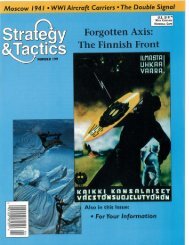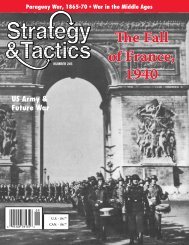the franco-prussian war - Strategy & Tactics
the franco-prussian war - Strategy & Tactics
the franco-prussian war - Strategy & Tactics
You also want an ePaper? Increase the reach of your titles
YUMPU automatically turns print PDFs into web optimized ePapers that Google loves.
COMBAT RESULTS TABLEEXPLANATION OF DISRUPTED RESULT(Omission): If a disrupted unit is disruptedagain, <strong>the</strong> two disruptions apply against <strong>the</strong>unit concurrently. Units which enter a hexoccupied by a disrupted unit become disrupted<strong>the</strong>mselves.GAME SCALE (Omission): Each hex represents100 meters from side to side. EachGame-Turn represents <strong>the</strong> passage of tenminutes of "real time."NormandyAs a result of post-publication playtesting, <strong>the</strong>following errata has been assembled to clarifyand correct various errors or ambiguities in <strong>the</strong>original game components.The errata for Normandy follows <strong>the</strong> sequenceof <strong>the</strong> Normandy rules folder.GAME EQUIPMENT (Omission): A completegame of Normandy should include <strong>the</strong>following: one set of die-cut units, onemapsheet, one rules folder, one Allied Order ofBattle sheet, two Combat Resolution Tables,and one die.UNlT TYPE SYMBOLS (Correction): Thereare no Armored Infantry units in <strong>the</strong> Normandycounter-mix. The counter-mix does includeeight Allied Naval Gunfire Support Missioncounters and a number of Entrenched markersfor both <strong>the</strong> Germans and <strong>the</strong> Allies. The topnumber on <strong>the</strong> Naval Gunfire units is <strong>the</strong>attack-support strength. The middle number is<strong>the</strong> defense-support strength. The bottomnumber is <strong>the</strong> range (in hexes) over which <strong>the</strong>Naval Gunfire units can support land combats(see naval Gunfire Support rules).MOVEMENT(C) (Correction): Units must be movedindividually, never in stacks.(L)(Clarification): It should be understood thatunits out of supply must move to<strong>war</strong>d aFriendly supply source (area).(N) (Clarification): Armor units may alwaysmove one hex (even if <strong>the</strong>y do not possesssufficient Movement Points to enter a givenhex) only if <strong>the</strong>y are in supply. UnsuppliedArmored units must pay <strong>the</strong> normal cost toenter each hex. Unsupplied Armored units maynot enter a hex if <strong>the</strong>y do not have sufficientMovement Points to pay <strong>the</strong> appropriate"entry cost."COMBAT(J)(Correction): Armor units may not attack, ifstacked solely with units which have a"defensive" only Combat Strength (see UnitType Symbols).NAVAL GUNFIRE SUPPORT(F) (Clarification): In effect, only one NavalGunfire Mission may support an attack ordefense of a single occupied hex. When asingle hex-group of Allied units is adjacent toand attacking more than one German occupiedhex, <strong>the</strong>re is nothing to prevent <strong>the</strong> AlliedPlayer from allocating a Naval attack-supportmission against each German occupied hexexcept range considerations.EXAMPLE (Correction): In this example, if <strong>the</strong>Allied Player employs a Medium Naval GunfireMission his Attack Strength would be raised to51. If a Heavy Naval Gunfire Mission is chosen<strong>the</strong> Allied Attack Strength would be raisedto 36.ZONES OF CONTROL(A) (Correction): There is an error in <strong>the</strong>movement example given in this Case.Assuming <strong>the</strong> Allied unit has a MovementAllowance of six or greater, <strong>the</strong> correctmovement expenditures are as follows: twoMovement Points to leave an Enemy controlledhex, three additional Movement Pointsto enter an Enemy controlled hex, and threeMovement Points to enter a Bocage hex (seeTerrain Effects Chart Errata also).ENTRENCHMENTGENERAL RULE (Clarification): An Entrenchedmarker should be placed on top ofentrenched units. Units may entrench in anyterrain except in fortification hexes. Entrenchedunits may disentrench and attackduring a Friendly Combat Phase.TERRAIN EFFECTS CHART (Clarification)The effects of terrain on combat are notcumulative, i.e., defending units benefit from<strong>the</strong> single most advantageous terrain effect.The combat terrain effect for River hexsides isonly applied when all attacking units areattacking across a River hexside. The for<strong>the</strong>xes # QQ 29 and RR 31 are also to betreated as Bocage hexes, i.e., armor cannotattack units in <strong>the</strong>se hexes, and Bocage hexmovement costs are applicable in <strong>the</strong>se hexes.Note: The cost to leave an Enemy Zone ofControl is one Movement Point for Allied unitswith a Movement Allowance of four or less,and two Movement Points for Allied units witha Movement Allowance of six or greater. Theword "additional" may be ignored.PARACHUTE INFANTRYGENERAL RULE (Correction): The AlliedPlayer receives eight (not seven) paratroopunits at <strong>the</strong> beginning of <strong>the</strong> game.(D) (Clarification): Paratroop units cannotmove or attack until <strong>the</strong>y are brought intosupply. If attacked before <strong>the</strong>y are brought intosupply <strong>the</strong>y have <strong>the</strong>ir Combat Strengthhalved for defense.GAME-TURN 1 PLAY SEQUENCEGERMAN UNlT PLACEMENT (Clarification):The fort hexes # QQ 29 and RR 31 are notconsidered partially sea-hexes. German unitsmay be initially deployed in <strong>the</strong>se forts.PARADROP (Clarification): Paratroop unitswhose drop zones are occupied by Germanunits must still consult <strong>the</strong> Scatter Table. Ifsuch units are scattered onto a non-Germanoccupied hex, or an unoccupied hex, <strong>the</strong>y mayland safely. If, due to scattering, Alliedparatroop units exceed stacking limiations,invert <strong>the</strong> excess units. As soon as <strong>the</strong> stack isin supply, <strong>the</strong> excess units must move toconform to <strong>the</strong> stacking limits. If <strong>the</strong>y can'tmove, <strong>the</strong>y are eliminated. After moving off,<strong>the</strong>y are turned upright and can functionnormally. [The non-inverted units may moveoff <strong>the</strong> stack instead, so long as <strong>the</strong> Stackingrules are obeyed by <strong>the</strong> end of <strong>the</strong> first AlliedMovement Phase in which <strong>the</strong> stack is insupply.] Inverted units are not counted in <strong>the</strong>Defense Strength of a stack, and areeliminated if <strong>the</strong> stack is eliminated, retreated,or involved in an exchange. In <strong>the</strong> case of anexchange, <strong>the</strong> inverted units are not countedby <strong>the</strong> German Player when maiching Alliedlosses. Note: This errata pertains only tooverstacking caused by Paradrop scattering.ALLIED FIRST MOVEMENT PHASE (Clarification):Allied units may not use <strong>the</strong> roadmovement rate on <strong>the</strong> first Allied Player-Turn.They may, however, use bridges to <strong>the</strong> extentof crossing bridged River or Flooded hexsidesby paying only <strong>the</strong> movement cost defined by<strong>the</strong> terrain in <strong>the</strong> hex being entered.VICTORY CONDITIONS (Clarification): TheVictory Points a<strong>war</strong>ded for exiting Allieddivisions (or division equivalents) off aparticular map edge may only be scored onceper map edge, i.e., <strong>the</strong>re are no additionalpoints a<strong>war</strong>ded for moving more than onedivision off a single map edge. Similarly,Victory Points are only a<strong>war</strong>ded for <strong>the</strong> singlemost deeply penetrating Allied unit regardlessof <strong>the</strong> number of Allied beachheads.LEVELS OF VICTORY (Correction): An AlliedDecisive Victory is achieved if <strong>the</strong> Allies score40 (not 49) or more Victory Points.COMBAT RESULTS TABLEEXPLANATION OF RESULTS (Omission):DRIAR: Units may not retreat in violation ofStacking limitations (Stacking limitationssre ineffect throuahout <strong>the</strong> Combat. Phase). Unitswhjch retreat into a Friendly occupied hexwhich is subsequently attacked during <strong>the</strong>same Combat Phase may not apply <strong>the</strong>irCombat Strength to<strong>war</strong>d <strong>the</strong> defense of <strong>the</strong>hex-group, but are affected by <strong>the</strong> results of<strong>the</strong> combat.As of October 1973, errata sheets for <strong>the</strong>following games are available:The American Revolution, The ArdennesOffensive, Austerlitz, Breakout B Pursuit, 1812(Strategic and Grand Tactical versions), ElAlamein, Franco-Prussian War, Grenadier, LaGrande Armee, Lee Moves North (new title forLee at Gettysburg), Leipzig, The Marne, TheMoscow Campaign, Musket & Pike, NATO,Normandy, Red StadWhite Star, Rifle 8Saber, Soldiers, <strong>Strategy</strong> I, and The WildernessCampaign.Games published in <strong>Strategy</strong> 8 <strong>Tactics</strong>Magazine:The Fall of Rome (SBT #391, CA (SBT #38),Scrimmage (SBT #37), Destruction of ArmyGroup Center (SBT #36), Year of <strong>the</strong> Rat(SBT #35), Armageddon (SBT #34), WinterWar (SBT #33), Borodino (SBT #32), FlyingCircus (SBT #31), Combat Command (SBT#30), U.S.N. (SBT #29), Lost Battles (SBT#28), Grunt (S&T #26), and Centurion(SBT #25).Errata for games o<strong>the</strong>r than those listed aboveis not yet available. As we make available newand/or updated additional errata sheets, anannouncement will be posted in ei<strong>the</strong>r SBT orMOVES. Please wait until errata for a particulargame has been announced as being availablebefore requesting it. Requests for errata sheetswill only be answered when accompanied by astamped, self-addressed envelope (one SSAEfor each sheet requested). O<strong>the</strong>r than that<strong>the</strong>y are free.







